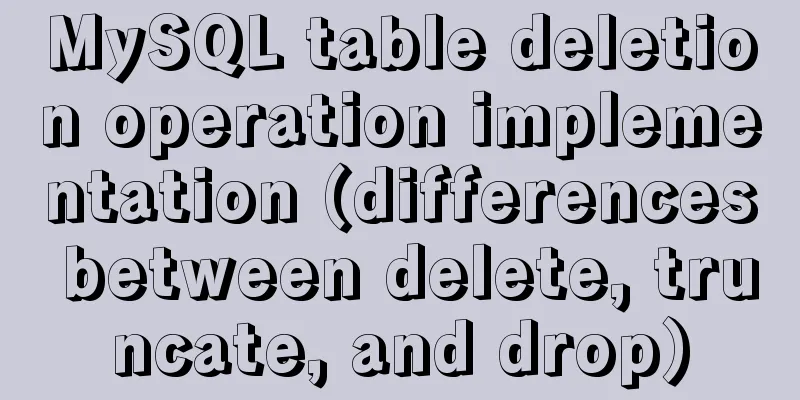MySQL table deletion operation implementation (differences between delete, truncate, and drop)

|
This article mainly discusses the differences between three operations of deleting tables in MySQL, the delete statement, the truncate statement, and the drop statement: Introduction delete 1. Delete the data of the entire table: delete from table_name; 2. Delete some data and add a where clause: delete from table_name where...; 3. Description 1) It belongs to DML language. Every time a row is deleted, an entry is recorded in the transaction log for each row deleted. A rollback is generated and takes effect only after the transaction is committed; if there is a corresponding trigger, it will be triggered during execution. If a table with a large amount of data is deleted, the speed will be very slow. truncate 1. You can only operate on the table and delete all the data in the table. Its function is the same as the delete statement without the where clause: truncate table table_name; 2. Description 1) By default, truncate deletes data by releasing the data pages used to store table data, and only records the release of pages in the transaction log. Therefore, less system and transaction log resources are used, and reuse storage can be used; truncate will reset the high watermark (back to the beginning). drop 1. The drop statement will delete the table structure, as well as the dependent constraints, triggers, and indexes; drop table table_name; 2. Note 1) After deletion, the stored procedures/functions that depend on the table will be retained, but will become invalid. the difference 1. Space occupied by tables and indexes: 2. Application scope: 3. Execution speed: 4. After deleting an empty table, delete from will retain an empty page, and truncate will not leave any pages in the table. 5. The process of executing the DELETE statement is to delete one row from the table each time, and at the same time save the deletion operation of the row as a transaction record in the log for rollback operation. TRUNCATE TABLE deletes all data from the table at once without logging individual deletion operations. Deleted rows cannot be recovered. And the delete triggers related to the table will not be activated during the deletion process. Fast execution speed. 6. When a DELETE statement is executed using a row lock, each row in the table will be locked for deletion. truncate always locks tables and pages, not individual rows. 7. If there is an auto-increment id column generated by identity, it will still increase from the last number after delete from, that is, the seed remains unchanged; After deleting using truncate, the seed will be restored to the initial value. Summarize 1. The delete statement can use the where clause to achieve partial deletion, but truncate cannot, which will delete all the data in the table. When using it, you can choose according to your needs; The above is the full content of this article. I hope it will be helpful for everyone’s study. I also hope that everyone will support 123WORDPRESS.COM. You may also be interested in:
|
<<: Detailed explanation of JavaScript to monitor route changes
>>: How to configure tomcat server for eclipse and IDEA
Recommend
A detailed introduction to the netstat command in Linux
Table of contents 1. Introduction 2. Output Infor...
The complete code of the uniapp packaged applet radar chart component
Effect picture: The implementation code is as fol...
An in-depth introduction to React refs
1. What is Refs is called Resilient File System (...
A brief discussion on VUE uni-app custom components
1. Parent components can pass data to child compo...
A brief discussion on the maximum number of open files for MySQL system users
What you learn from books is always shallow, and ...
Vue implements click and passes in event objects and custom parameters at the same time
Just pass in custom parameters HTML <div id=&q...
Detailed explanation of various types of image formats such as JPG, GIF and PNG
Everyone knows that images on web pages are genera...
Detailed analysis of javascript data proxy and events
Table of contents Data Brokers and Events Review ...
js realizes the magnifying glass effect of shopping website products
This article shares the specific code of js to ac...
Comparing the performance of int, char, and varchar in MySQL
There are many seemingly true "rumors" ...
Implementation steps of Mysql merge results and horizontal splicing fields
Preface Recently, I was working on a report funct...
The difference between distinct and group by in MySQL
Simply put, distinct is used to remove duplicates...
Difference between HTML ReadOnly and Enabled
The TextBox with the ReadOnly attribute will be di...
The magic of tr command in counting the frequency of English words
We are all familiar with the tr command, which ca...
Key issues and solutions for web page access speed
<br /> The website access speed can directly...









